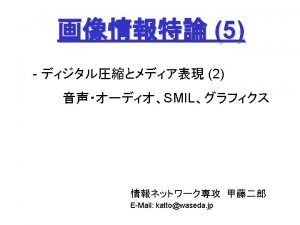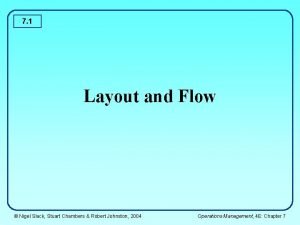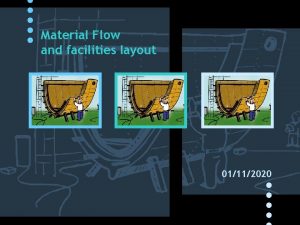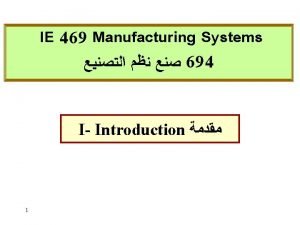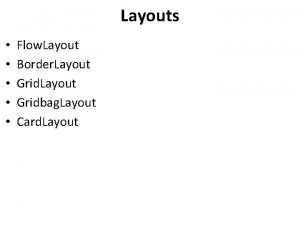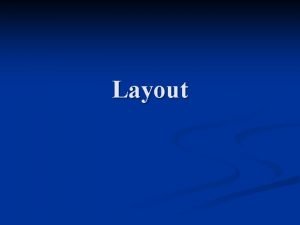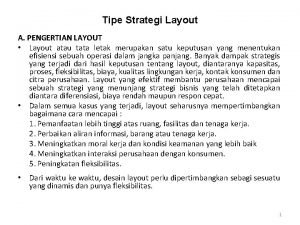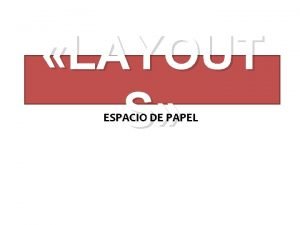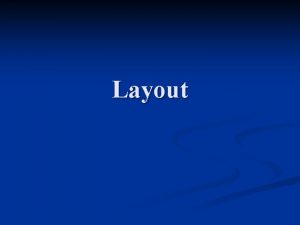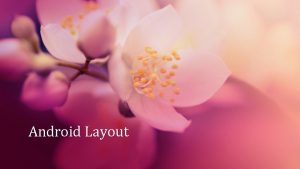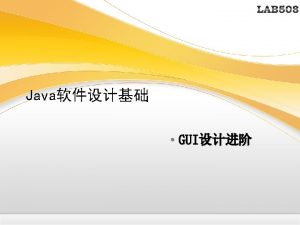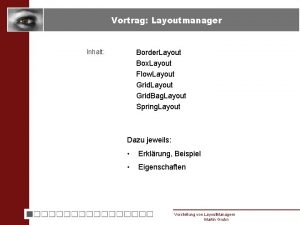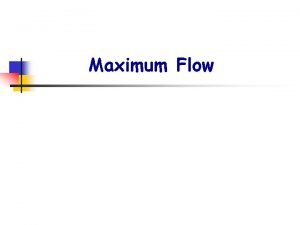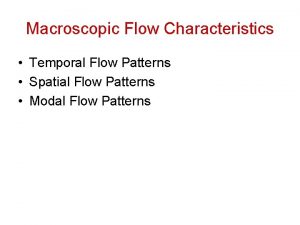Flow Layout set Layoutnew Flow Layout set Layoutnew





































![public class Frm. Samp 2{ public static void main(String args[]){ My. Frame frm = public class Frm. Samp 2{ public static void main(String args[]){ My. Frame frm =](https://slidetodoc.com/presentation_image_h2/783ff06141d0d58f6606d6c8411a2c23/image-38.jpg)



- Slides: 41






Flow. Layout デフォルトの設定 set. Layout(new Flow. Layout()); は set. Layout(new Flow. Layout(Flow. Layout. Center, 5, 5) と同様。

Flow. Layout 例 import java. awt. *; import java. applet. *; /* <APPLET CODE="Flow. Lay 1. class" WIDTH=400 HEIGHT=120> </APPLET> */ public class Flow. Lay 1 extends Applet{ public void init(){ set. Layout(new Flow. Layout()); //デフォルトは、Flow. Layout(Flow. Layout. Center, 5, 5)と同 様

Button btn 1 = new Button("ボタン 1"); add(btn 1); Button btn 2 = new Button("ボタン 2"); add(btn 2); Button btn 3 = new Button("ボタン 3"); add(btn 3); } public void paint(Graphics g){ g. set. Color(Color. blue); g. set. Font(new Font("Serif", Font. BOLD + Font. ITALIC, 26)); g. draw. String("Flow. Layoutの ", 50, 100); //←x, y g. set. Color(Color. red); g. draw. String(" テスト!", 220, 100); } }

Flow. Layout 実行結果

Boader. Layout コンポーネントを中央を中心にして、東西南北に配置。 North West Center East South 書式: Boader. Layout(int hgaps, int vgaps) hgaps:水平方向の間隔 vgaps:垂直方向の間隔 指定の方法: set. Layout(new Boader. Layout(5, 5)); Button bt 1 = new Button(“button-North”); add(bt 1, “North” ); (または add(bt 1, Boader. Layout. NORTH ); )

Boader. Layout 配置の位置 北 設定名 中央 南 東 西 “Center”または、Border. Layout. CENTER “South” または、Border. Layout. SOUTH “East” または、Border. Layout. EAST “West” または、Border. Layout. WEST “North” または、Border. Layout. NORTH

Boader. Layout 例 import java. awt. *; import java. applet. *; /* <APPLET CODE="Border. Lay 1. class" WIDTH=400 HEIGHT=220> </APPLET> */ public class Border. Lay 1 extends Applet { public void init(){ set. Layout(new Border. Layout()); //デフォルトは、Border. Layout(5, 5)と同様t

Button btn 1 = new Button("ボタン 1"); add(btn 1, "North"); Button btn 2 = new Button("ボタン 2"); add("South", btn 2); Button btn 3 = new Button("ボタン 3"); } public void paint(Graphics g) { g. set. Color(Color. blue); g. set. Font(new Font("Serif", Font. BOLD + Font. ITALIC, 26)); g. draw. String("Border. Layout の ", 50, 100); //←x, y g. set. Color(Color. red); g. draw. String(" テスト!", 220, 100); } }

Boader. Layout 実行結果


Grid. Layout import java. awt. *; import java. applet. *; /* <APPLET CODE="Grid. Lay 1. class" WIDTH=400 HEIGHT=220> </APPLET> */ public class Grid. Lay 1 extends Applet { public void init() { set. Layout(new Grid. Layout(2, 3));

Button btn; for (int i = 1; i <= 9; i++){ add(btn = new Button("ボタン" + Integer. to. String(i))); } } public void paint(Graphics g){ g. set. Color(Color. blue); g. set. Font(new Font("Serif", Font. BOLD + Font. ITALIC, 26)); g. draw. String("Grid. Layoutの ", 50, 270); g. set. Color(Color. red); g. draw. String(" テスト!", 220, 270); } }

Grid. Layout 実行結果



null. Layout(絶対位置の指定) import java. awt. *; import java. applet. *; /* <APPLET CODE="set. Bond 1. class" WIDTH=400 HEIGHT=300> </APPLET> */ public class set. Bond 1 extends Applet{ public void init(){ set. Layout(null); Button btn 1 = new Button("ボタン 1"); btn 1. set. Bounds(100, 60, 50); add(btn 1);

Button btn 2 = new Button("ボタン 2"); btn 2. set. Bounds(100, 150, 60, 50); add(btn 2); Button btn 3 = new Button("ボタン 3"); btn 3. set. Bounds(100, 200, 60, 50); add(btn 3); } public void paint(Graphics g){ g. set. Color(Color. blue); g. set. Font(new Font("Serif", Font. BOLD + Font. ITALIC, 26)); g. draw. String("set. Bounds の ", 50, 60); g. set. Color(Color. red); g. draw. String(" テスト!", 220, 60); } }










例. 描画 import java. awt. *; import java. awt. event. *; class My. Frame extends Frame{ public My. Frame(String title){ set. Title(title); add. Window. Listener(new Window. Adapter(){ public void window. Closing(Window. Event e){ System. exit(0); } }); } public void paint(Graphics g){ String ss = "ABCabc"; int aa = 20, height=30, width=140;

g. draw. String(ss, aa, 50); g. set. Font(new Font("Serif", Font. BOLD, 24)); g. draw. String(ss, aa, 80); g. draw. Rect(aa, 90, width, height); g. fill. Rect(aa, 130, width, height); } } public class Frm. Samp 1{ public static void main(String args[]){ My. Frame frm = new My. Frame("描画"); frm. set. Size(230, 180); frm. set. Visible(true); } }


例2.マウス import java. awt. *; import java. awt. event. *; class My. Frame extends Frame implements Mouse. Listener{ int x 1=-1, y 1, x 2 = 999, y 2; public My. Frame(String title){ set. Title(title); add. Window. Listener(new Window. Adapter(){ public void window. Closing(Window. Event e){ System. exit(0); } }); add. Mouse. Listener(this); }

public void paint(Graphics g){ if (x 1 != -1){ if(x 2 != -1){ g. draw. Line(x 1, y 1, x 2, y 2); } else { g. fill. Rect(x 1, y 1, 1, 1); } } } public void mouse. Entered(Mouse. Event me){} public void mouse. Exited(Mouse. Event me){}

public void mouse. Clicked(Mouse. Event me){ if (x 2 != -1){ x 1 = me. get. X(); y 1 = me. get. Y(); x 2 = -1; }else { x 2 = me. get. X(); y 2 = me. get. Y(); } repaint(); } public void mouse. Pressed(Mouse. Event me){} public void mouse. Released(Mouse. Event me){} }
![public class Frm Samp 2 public static void mainString args My Frame frm public class Frm. Samp 2{ public static void main(String args[]){ My. Frame frm =](https://slidetodoc.com/presentation_image_h2/783ff06141d0d58f6606d6c8411a2c23/image-38.jpg)
public class Frm. Samp 2{ public static void main(String args[]){ My. Frame frm = new My. Frame("マウス"); frm. set. Size(300, 200); frm. set. Visible(true); } } 実行結果

例3.コンポーネント利用 import java. awt. *; import java. awt. event. *; class My. Frame extends Frame implements Action. Listener{ Button btn; Text. Field txt; public My. Frame(String title){ set. Title(title); set. Layout(null); add. Window. Listener(new Window. Adapter(){ public void window. Closing(Window. Event e){ System. exit(0); } }); btn= new Button("表示"); btn. add. Action. Listener(this); add(btn);

btn. set. Bounds(60, 70, 100, 25); txt=new Text. Field(""); add(txt); txt. set. Bounds(40, 140, 20); } public void action. Performed(Action. Event e){ txt. set. Text("ボタン押下"); } } public class Frm. Samp 3{ public static void main(String args[]){ My. Frame frm = new My. Frame("コンポーネント"); frm. set. Size(220, 120); frm. set. Visible(true); }

 Total set awareness set consideration set
Total set awareness set consideration set Training set validation set test set
Training set validation set test set Denominator layout
Denominator layout Smil head layout root-layout
Smil head layout root-layout Mpeg-1
Mpeg-1 Liquid layout website
Liquid layout website Bounded set vs centered set
Bounded set vs centered set Fucntions
Fucntions Crisp set vs fuzzy set
Crisp set vs fuzzy set Crisp set vs fuzzy set
Crisp set vs fuzzy set What is the overlap of data set 1 and data set 2?
What is the overlap of data set 1 and data set 2? The function from set a to set b is
The function from set a to set b is Flexible flow layout
Flexible flow layout Precedensdiagram
Precedensdiagram Job shop process layout
Job shop process layout Contoh layout toko
Contoh layout toko Layout and flow
Layout and flow Drain gang flowchart
Drain gang flowchart Material flow layout
Material flow layout Ie 469
Ie 469 Layout toko
Layout toko Wpf flow layout
Wpf flow layout Medicare set-aside flow chart
Medicare set-aside flow chart Rebreathing mask
Rebreathing mask Oxygen reservoir mask
Oxygen reservoir mask High flow versus low flow oxygen
High flow versus low flow oxygen Definition of laminar flow and turbulent flow
Definition of laminar flow and turbulent flow External flow
External flow Energy naturally flows from warmer matter to cooler matter.
Energy naturally flows from warmer matter to cooler matter. Oikos meaning
Oikos meaning Dfd to structure chart
Dfd to structure chart Data flow structure
Data flow structure Irrotational flow meaning
Irrotational flow meaning External flow vs internal flow
External flow vs internal flow Data flow vs control flow
Data flow vs control flow Cheese making process diagram
Cheese making process diagram Control flow and data flow computers
Control flow and data flow computers Transaction flow graph
Transaction flow graph Eyeline yearbook example
Eyeline yearbook example Purpose audience language layout
Purpose audience language layout Format of an open letter
Format of an open letter Welcome to word
Welcome to word




